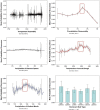Assessing the Impact of Climate Change on Potential Distribution of Meconopsis punicea and Its Influence on Ecosystem Services Supply in the Southeastern Margin of Qinghai-Tibet Plateau
- PMID: 35095992
- PMCID: PMC8792861
- DOI: 10.3389/fpls.2021.830119
Assessing the Impact of Climate Change on Potential Distribution of Meconopsis punicea and Its Influence on Ecosystem Services Supply in the Southeastern Margin of Qinghai-Tibet Plateau
Abstract
Meconopsis punicea is an iconic ornamental and medicinal plant whose natural habitat has degraded under global climate change, posing a serious threat to the future survival of the species. Therefore, it is critical to analyze the influence of climate change on possible distribution of M. punicea for conservation and sustainable utilization of this species. In this study, we used MaxEnt ecological niche modeling to predict the potential distribution of M. punicea under current and future climate scenarios in the southeastern margin region of Qinghai-Tibet Plateau. Model projections under current climate show that 16.8% of the study area is suitable habitat for Meconopsis. However, future projections indicate a sharp decline in potential habitat for 2050 and 2070 climate change scenarios. Soil type was the most important environmental variable in determining the habitat suitability of M. punicea, with 27.75% contribution to model output. Temperature seasonality (16.41%), precipitation of warmest quarter (14.01%), and precipitation of wettest month (13.02%), precipitation seasonality (9.41%) and annual temperature range (9.24%) also made significant contributions to model output. The mean elevation of suitable habitat for distribution of M. punicea is also likely to shift upward in most future climate change scenarios. This study provides vital information for the protection and sustainable use of medicinal species like M. punicea in the context of global environmental change. Our findings can aid in developing rational, broad-scale adaptation strategies for conservation and management for ecosystem services, in light of future climate changes.
Keywords: MaxEnt modeling; Meconopsis punicea; Qinghai-Tibet Plateau; climate change; ecosystem service; habitat suitability.
Copyright © 2022 Shi, Naudiyal, Wang, Gaire, Wu, Wei, He and Wang.
Conflict of interest statement
The authors declare that the research was conducted in the absence of any commercial or financial relationships that could be construed as a potential conflict of interest.
Figures





References
-
- Ackerly D. D., Loarie S. R., Cornwell W. K., Weiss S. B., Hamilton H., Branciforte R., et al. (2010). The geography of climate change: implications for conservation biogeography. Divers. Distrib. 16 476–487. 10.1111/j.1472-4642.2010.00654.x - DOI
-
- Al-Qaddi N., Vessella F., Stephan J., Al-Eisawi D., Schirone B. (2017). Current and future suitability areas of kermes oak (Quercus coccifera L.) in the Levant under climate change. Region. Environ. Change 17 143–156. 10.1007/s10113-016-0987-2 - DOI
LinkOut - more resources
Full Text Sources

